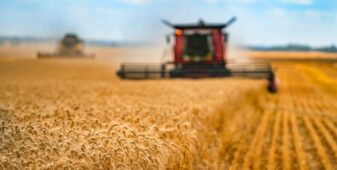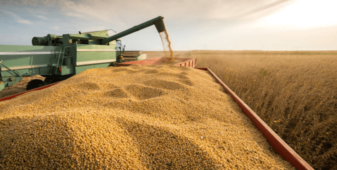Introduction
Grains production is responsible for more than 50% of Brazilian agribusiness. Soybean is the most produced crop in Brazil with around 155m tonnes made during the 2022/23 harvest.
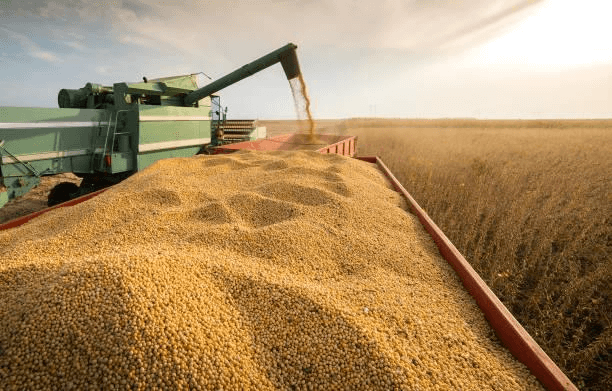
Soybeans are the most valuable crop in Brazil, perhaps because of its versatility; it can be used by a diverse range of industries. As a result, it’s critical for Brazilian rural employment. Around 243,000 producers employ 1.4m people across the country directly and indirectly.
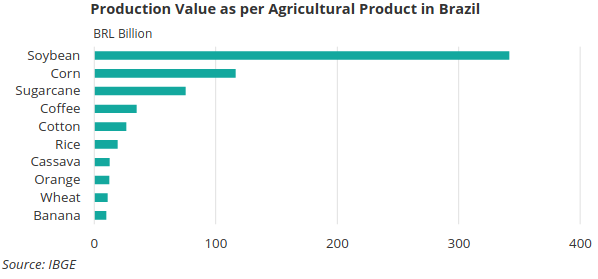
Production
Production growth has been mainly driven by increased global demand. This has encouraged Brazilian farmers to expand their soybean acreage; among the world’s largest soybean producers, Brazil has the greatest capacity to expand soybean cultivated area.
Compared to other crops, grains have a short production cycle, lasting a maximum of 1 year. This is unlike the production cycle for sugar cane or many fruits, which yield year after year. This means grains farmers have fewer long term commitments to the crop and can adapt planting plans according to prices paid. Cost of soybean production is also low relative to many other crops.
Cultivation
Brazil is the world’s largest soybean producer, followed by the United States.
Soybeans are mostly cultivated in Center-West region of Brazil. The cultivation cycle lasts around 115 – 130 days. During its development, soybean is strongly dependent on weather conditions; notably, a good distribution of rainfall is required for high yields.

In the states of Mato Grosso and Goiás, where the climate is humid-tropical with a well-defined rainy season, productivity ranges between 3.5 and 3.9 tonnes/ha. States such as Rio Grande do Sul, where the weather is predominantly subtropical (cold and dry), soybean productivity tends to be below the average for Brazil.
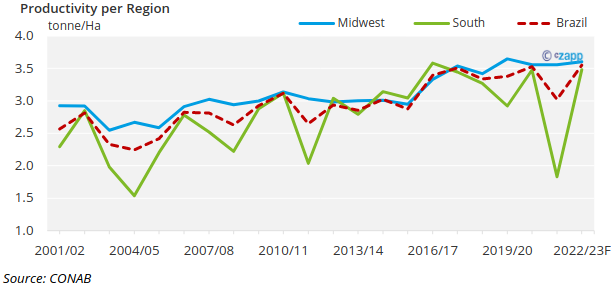
Rainfall is especially important during the plant’s reproductive period. At this stage, the formation of the soybean pods occurs and the plant requires up to 8mm/day. In case of water stress during this phase, crop yield can be drastically reduced, with losses up to 80-100%.
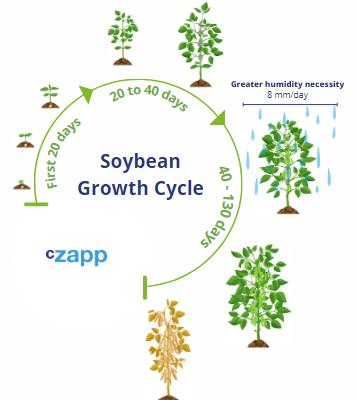
Excessive rains can also be a problem. Grains need to be dry during harvesting, and high humidity can lead to soybeans rotting inside the pod.
Despite the need for good rain distribution, only 5% of soybean farms in Brazil are irrigated, due to the high costs of installing and maintaining irrigation systems.
Brazilian Soybean Crops
Soybeans are a summer crop, with planting carried out between the months of September and December in the main producing regions of the country.

In Brazil, crop rotation with soybeans is very popular and widely used, with corn as the main alternative crop, followed by wheat. This practice improves soil fertility and soil structure, increasing yields and helping to reduce soil erosion, as well as reducing the need for fertilizers. It also helps prevent pests/diseases by interrupting their life cycles between the crops.
Producers generally opt for corn as an alternative crop because it provides the best returns. The most common practice is to rotate with corn at least once every 3 years; many producers alternate between the two crops as they have complementary calendars.
The average productivity of soybeans in the rotation system with first-crop corn is 12% higher compared to the rotation with second-crop corn (winter crop/safrinha).
How are Soybeans Stored?
Once the soybeans have been harvested, they must be cleaned and dried before storage. In Brazil there are then two common storage methods.
The first is in bulk bags (also known as “silo bags”). Silo bags are best suited for short-term storage (a few months) and are most often used as an emergency method when storing large volumes to support harvesting logistics. The bags are 40 to 90 meter-long sacks that can hold around 200 – 300 tonnes of soybeans. Silo bags need weekly inspection to reduce the chance of grain spoiling from excess moisture or pest attacks.

The second storage method is in traditional silos. They are more suitable for long-term storage and provide better control over the storage environment. Conventional silos can store around 3,000 tonnes of soybeans, but have higher costs and require more auxiliary equipment.
One of the benefits of storing soybean production is it allows the crop to be carried and sold at better returns, avoiding market pressures during harvest times.
Exports
Today, Brazil is the world’s largest soybean exporter, accounting for more than half of international soybean market supply. Over 60% of Brazilian production is destined for export, with China the main destination.

Brazil became the largest soybean exporter in the 2012/13 harvest, when it overtook the United States and has remained in first place ever since.
Export growth has been influenced by increasing Chinese demand for the grain, mostly soybean meal for animal feed.
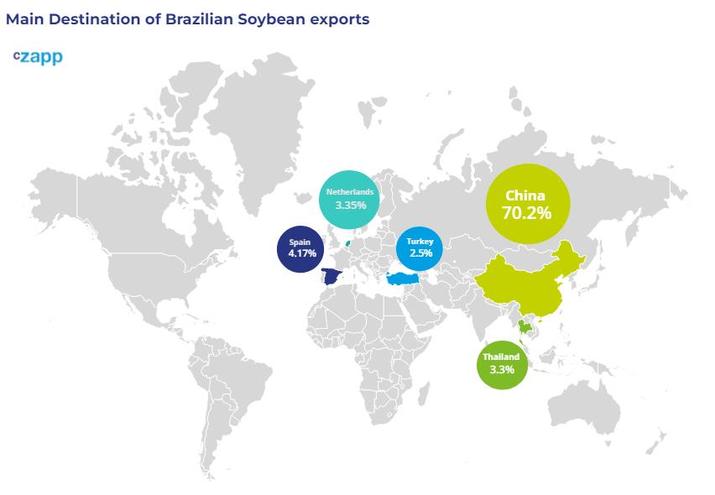
Around 60% of Brazilian soybean exports occur between March and June, mainly in the port of Santos, which accounts for 30% of the total exports, sending over 18 tonnes of soybeans overseas every year. Paranagua and Rio Grande are the two next-largest soybean ports and are located in the south of the country. Together they are responsible for another 30% of exports.
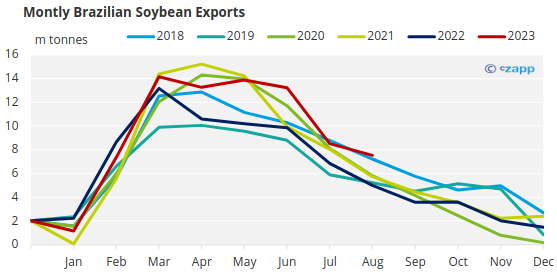
Source: Comex Stat
Trade houses are responsible for most of the volume exported. Global traders such as Louis Dreyfus, Cargill, Cofco, and Bunge account for 70% of global grain market sales and are also the largest exporters of Brazilian grain.
In Brazil, when exporting soybeans to the international market, the export premium must be considered.
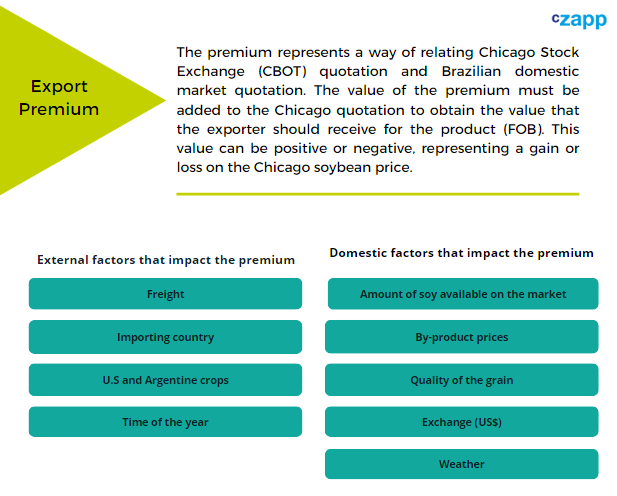
Logistics
One of the great challenges of Brazilian soybean exports is logistics. Brazil is a huge country and inland logistics are mainly road-dependent.
Soybean production areas are far from the ports. Brazilian soybean farms are concentrated inland. Mato Grosso state, which is the largest producer and exporter of soybeans, has no seaports within a 900 km radius.
The long distances between soybean-producing regions and the ports affect the FOB price of the commodity.
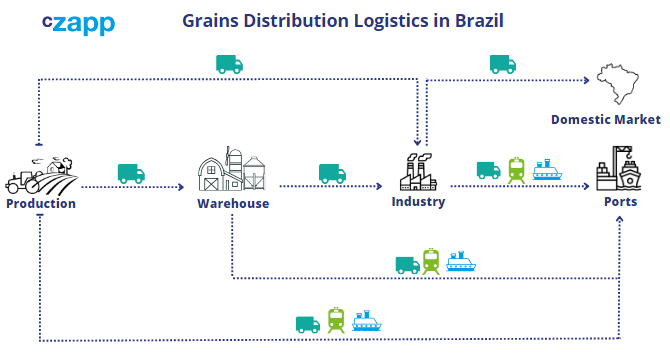
All sugar terminals now operate grains as well, which ends up generating competition between commodities for logistical capacity in Santos and Paranagua ports.
Competition between commodities generates bottlenecks in the country’s main ports, which not only results in delays in shipments and allocation of wagons to the port, but also increases freight rates.
How Are Soybeans Used in Brazil?
Soybeans have many uses in Brazil. As well as exports, it can be crushed in Brazil, which transforms the grain into meal or oil for use in the domestic or international market.
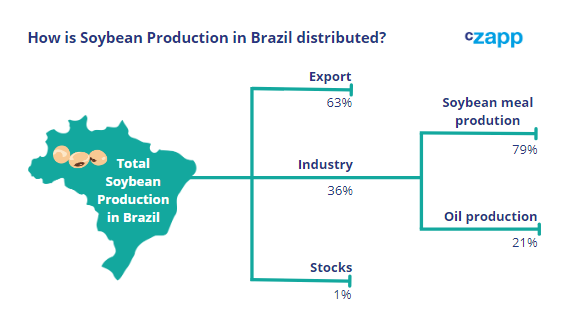
Soy meal (resulting from the removal of oil from grains) is one of the most used by-products in animal feed, as it has a high protein and energy content. In Brazil, 80% of soybean meal makes up, together with corn, the basic feed produced to feed cattle, pigs, goats, sheep, and poultry.
Despite the high demand, the livestock sector is not the only one interested in soy. Soy oil is used by the food, pharmaceutical and biodiesel industries. In Brazil, soy oil currently represents over 80% of the total demand for biodiesel production.
The rapid growth in demand for soybean explains the continuous increase in planted area in Brazil, up 20% since 2017.
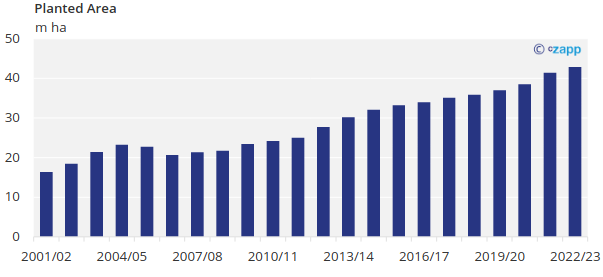
Soybeans in the Future Market
Soybean futures in Brazil are traded on the CME group’s CBOT (Chicago Board of Trades) market.

In Brazil, soybean prices on the domestic market are directly influenced by factors such as freight, production costs, crop production, taxes, and external factors such as the dollar exchange rate and prices on the international market (given that most of the production in Brazil is due for export). This explains the different prices in different markets in Brazil (cities that serve as a reference for price formation in different regions).
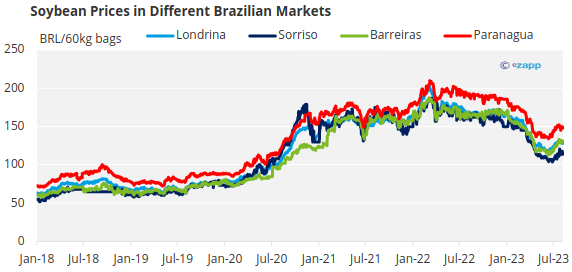
Hedging by Brazilian rural producers is still low, mainly due to the lack of knowledge of the subject. Most operations in the futures market are carried out by trading companies, which negotiate in the spot market with producers. This means there is low liquidity in Brazilian agricultural futures markets. Therefore, despite Brazil’s great influence on the commodities market, Bm&fBovespa is not a price reference in any of them.
Thus, the physical basis is used for negotiations. This is the difference between the spot price in each market and the price on the reference exchange.
Soybeans are also often sold through barter. The soybeans can be used as payment for production inputs. Negotiations are made with the supplier before harvest, allowing the producer to use the necessary inputs during the planting process, and at the end of the harvest payment is made with the products obtained from the farm.


